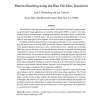Free Online Productivity Tools
i2Speak
i2Symbol
i2OCR
iTex2Img
iWeb2Print
iWeb2Shot
i2Type
iPdf2Split
iPdf2Merge
i2Bopomofo
i2Arabic
i2Style
i2Image
i2PDF
iLatex2Rtf
Sci2ools
114
Voted
JEI
2000
2000
Pattern matching using the blur hit - miss transform
The usefulness of the hit-miss transform (HMT) and related transforms for pattern matching in document image applications is examined. Although the HMT is sensitive to the types of noise found in scanned images, including both boundary and random noise, a simple extension, the Blur HMT, is relatively robust. The noise immunity of the Blur HMT derives from its ability to treat both types of noise together, and to remove them by appropriate dilations. In analogy with the Hausdorff metric for the distance between two sets, metric generalizations for special cases of the Blur HMT are derived. Whereas Hausdorff uses both directions of the directed distances between two sets, a metric derived from a special case of the Blur HMT uses just one direction of the directed distances between foreground and background components of two sets. For both foreground and background, the template is always the first of the directed sets. A less restrictive metric generalization, where the disjoint foregro...
Related Content
| Added | 19 Dec 2010 |
| Updated | 19 Dec 2010 |
| Type | Journal |
| Year | 2000 |
| Where | JEI |
| Authors | Dan S. Bloomberg, Luc Vincent |
Comments (0)

